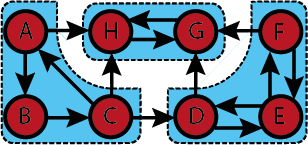Strongly connected components: Difference between revisions
No edit summary |
|||
| Line 1: | Line 1: | ||
== Definition == | == Definition == | ||
[[File:Scc.png|300px|thumb|right|Graph with marked strongly connected components]] | [[File:Scc.png|300px|thumb|right|Graph with marked strongly connected components]] | ||
Let <math>G=(V,A)</math> be a [[Basic graph definitions|directed graph]]. Consider the following equivalence relation on the nodes: <math>v\in V</math> and <math>w\in V</math> are equivalent if, and only if, there is a path | Let <math>G=(V,A)</math> be a [[Basic graph definitions|directed graph]]. Consider the following equivalence relation on the nodes: <math>v\in V</math> and <math>w\in V</math> are equivalent if, and only if, there is a path from <math>v</math> to <math>w</math> and a path from <math>w</math> to <math>v</math> in <math>G</math>. The equivalence classes are called the '''strongly connected components (SCC)''' of <math>G</math>. | ||
== Input == | == Input == | ||
Revision as of 15:54, 23 October 2014
Definition
Let [math]\displaystyle{ G=(V,A) }[/math] be a directed graph. Consider the following equivalence relation on the nodes: [math]\displaystyle{ v\in V }[/math] and [math]\displaystyle{ w\in V }[/math] are equivalent if, and only if, there is a path from [math]\displaystyle{ v }[/math] to [math]\displaystyle{ w }[/math] and a path from [math]\displaystyle{ w }[/math] to [math]\displaystyle{ v }[/math] in [math]\displaystyle{ G }[/math]. The equivalence classes are called the strongly connected components (SCC) of [math]\displaystyle{ G }[/math].
Input
A directed graph [math]\displaystyle{ G=(V,A) }[/math].
Output
A set of sets of nodes. Each set of nodes contains exactly the nodes of one SCC. The correspndence between SCC and sets of nodes is one-to-one.
Pseudocode
STRONGLY-CONNECTED-COMPONENTS(D)
STRONGLY-CONNECTED-COMPONENTS(D)
1 call DFS(D) to compute finishing times f[v] for each vertex v ∈ V
2 compute DT (w.r.t. step 3)
3 call DFS(DT), but in the main loop of DFS, consider the vertices in order of decreasing f[v] as computed in step 1
4 output the vertices of each tree in the DFS forest of step 3 as a separate strongly connected component
